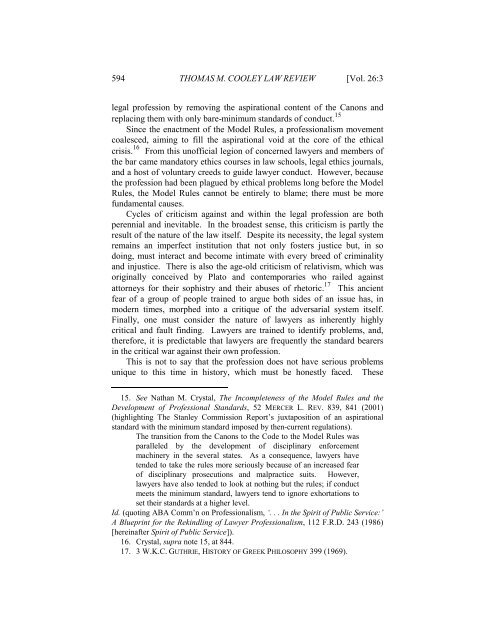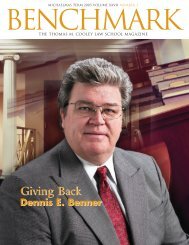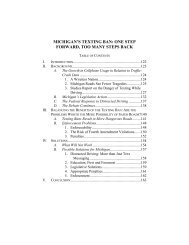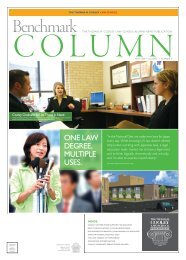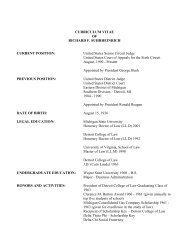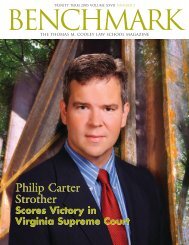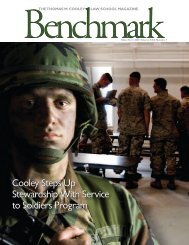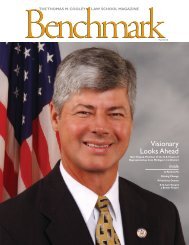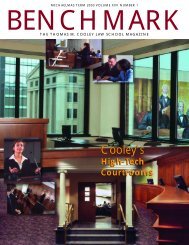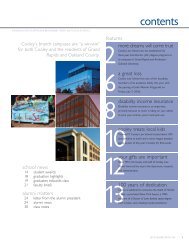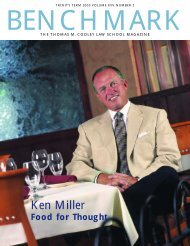Beyond The Model Rules - Thomas M. Cooley Law School
Beyond The Model Rules - Thomas M. Cooley Law School
Beyond The Model Rules - Thomas M. Cooley Law School
You also want an ePaper? Increase the reach of your titles
YUMPU automatically turns print PDFs into web optimized ePapers that Google loves.
594 THOMAS M. COOLEY LAW REVIEW [Vol. 26:3legal profession by removing the aspirational content of the Canons andreplacing them with only bare-minimum standards of conduct. 15Since the enactment of the <strong>Model</strong> <strong>Rules</strong>, a professionalism movementcoalesced, aiming to fill the aspirational void at the core of the ethicalcrisis. 16 From this unofficial legion of concerned lawyers and members ofthe bar came mandatory ethics courses in law schools, legal ethics journals,and a host of voluntary creeds to guide lawyer conduct. However, becausethe profession had been plagued by ethical problems long before the <strong>Model</strong><strong>Rules</strong>, the <strong>Model</strong> <strong>Rules</strong> cannot be entirely to blame; there must be morefundamental causes.Cycles of criticism against and within the legal profession are bothperennial and inevitable. In the broadest sense, this criticism is partly theresult of the nature of the law itself. Despite its necessity, the legal systemremains an imperfect institution that not only fosters justice but, in sodoing, must interact and become intimate with every breed of criminalityand injustice. <strong>The</strong>re is also the age-old criticism of relativism, which wasoriginally conceived by Plato and contemporaries who railed againstattorneys for their sophistry and their abuses of rhetoric. 17 This ancientfear of a group of people trained to argue both sides of an issue has, inmodern times, morphed into a critique of the adversarial system itself.Finally, one must consider the nature of lawyers as inherently highlycritical and fault finding. <strong>Law</strong>yers are trained to identify problems, and,therefore, it is predictable that lawyers are frequently the standard bearersin the critical war against their own profession.This is not to say that the profession does not have serious problemsunique to this time in history, which must be honestly faced. <strong>The</strong>se15. See Nathan M. Crystal, <strong>The</strong> Incompleteness of the <strong>Model</strong> <strong>Rules</strong> and theDevelopment of Professional Standards, 52 MERCER L. REV. 839, 841 (2001)(highlighting <strong>The</strong> Stanley Commission Report’s juxtaposition of an aspirationalstandard with the minimum standard imposed by then-current regulations).<strong>The</strong> transition from the Canons to the Code to the <strong>Model</strong> <strong>Rules</strong> wasparalleled by the development of disciplinary enforcementmachinery in the several states. As a consequence, lawyers havetended to take the rules more seriously because of an increased fearof disciplinary prosecutions and malpractice suits. However,lawyers have also tended to look at nothing but the rules; if conductmeets the minimum standard, lawyers tend to ignore exhortations toset their standards at a higher level.Id. (quoting ABA Comm’n on Professionalism, ‘. . . In the Spirit of Public Service:’A Blueprint for the Rekindling of <strong>Law</strong>yer Professionalism, 112 F.R.D. 243 (1986)[hereinafter Spirit of Public Service]).16. Crystal, supra note 15, at 844.17. 3 W.K.C. GUTHRIE, HISTORY OF GREEK PHILOSOPHY 399 (1969).


